

Vapor Intrusion Guidance Update Cleanup Standards Scientific Advisory Board Meeting Dec. 17, 2014 Tom Corbett, Governor Dana Aunkst, Acting Secretary
Timeline Old version presented at March 19 Cleanup Standards Scientific Advisory Board (CSSAB) meeting Conference calls with VI Workgroup in April/May Last update for Regions in June Presented revised version to CSSAB in July More calls with VI Workgroup in August/September Regional staff reviewed in mid-October. Routed for internal review in early November. Sent to CSSAB members for review in early December.
2004 Guidance Limitations Confusion with how to handle VI under site-specific standard (SSS). Indoor air “MSCs” are not really MSCs. Screening values too high? Confusion addressing future onsite structures. Minimal sampling guidance. No discussion of petroleum vapor intrusion (PVI). Confusion with “background” reference.
July 2014 Version of VI Guidance Screening or Lines of Evidence Screening Option Limiting conditions Allowed for groundwater and soil VI screening Petroleum proximity distances Allowed for indoor air, sub-slab soil gas or near-source soil gas screening Lines of Evidence (LOE) Option Single lines of evidence Multiple lines of evidence
July 2014 Version of VI Guidance Lines of Evidence Single LOE Mitigation with EC Sub-slab soil gas screening Indoor air screening Multiple LOE Near-source soil gas screening Evaluate soil type and permeability Evaluate depth to source Modeling
July 2014 Version of VI Guidance Separate Sections Accessing Inhabited Buildings on Neighboring Properties When OSHA PELs Apply Demonstrating Attainment
Problems with July 2014 Version No definitions of important terms How to address VI under SSS? Attainment language misleading Near-source soil gas screening should be single line of evidence Format and flow charts did not flow well
Key Changes from July 2014 Version Reorganized for clarity Added definitions and uses of key terms Consolidated multiple flow charts into one Moved preferential pathways to beginning Moved proximity distance screen near beginning creating “VI Areas of Potential Concern”
Key Changes from July 2014 Version Moved near-source soil gas sampling to single line of evidence – eliminated LOE language Removed “attainment language” and replaced with “address Ch. 250 Requirements” language Added SSS section – separate process
Current Version of VI Guidance Proposed SHS Process Identify Preferential Pathways Identify VI AOPCs – Proximity Screening Identify Limiting Conditions Screen Soil and Groundwater Data Apply Alternate VI Assessment Options Indoor air, near-source, or sub-slab soil gas screening Modeling Address Regulatory Requirements
Current Version of VI Guidance At any stage in the Investigation… Mitigation with Environmental Covenant (EC) is always an option EC for future construction • Can evaluate future structures for VI • Can construct future structures with mitigation systems
Current Version of VI Guidance Identify Preferential Pathways Definition- A natural or man‐made feature that acts as a conduit for vapor transport by enhancing vapor migration from contaminated environmental media through soil or soil‐like material to an existing or future inhabited building. Use – One major change “Typical utility lines and their foundation penetrations in single-family homes and similarly sized buildings are not considered preferential pathways.”
Current Version of VI Guidance Identify Areas of Potential VI Concern Use Proximity Distances Non-Petroleum • Less than 100 feet horizontal distance • No vertical proximity distance Petroleum-Only • Less than 30 horizontal feet • Less than 6 vertical feet (under proper conditions) • Less than 15 vertical feet if SPL present
Current Version of VI Guidance Identify Potential VI Sources Other conditions limiting the use of soil and groundwater screening values 1. Separate Phase Liquids 2. Depth to Source Less than Five Feet
Current Version of VI Guidance Soil and Groundwater Screen Can use only if no limiting conditions exist Soil screening values are higher of: 1. Generic soil-to-GW MSC and, 2. Values calculated using equilibrium partitioning Groundwater screening values are higher of: 1. Groundwater MSC and, 2. Values calculated using EPA’s attenuation factors
Current Version of VI Guidance Alternative VI Assessment Options 1. Sub-slab soil gas concentrations < SV SS for existing buildings 2. Indoor air concentrations < SV IA at existing buildings 3. Near-source soil gas concentrations < SV NS 4. VI modeling using acceptable input parameters
Current Version of VI Guidance Addressing Regulatory Requirements Sampling design and statistical tests Additional guidance on using the soil, groundwater, soil gas and indoor air screening values Additional guidance on using ECs and activity and use limitations (AULs) to evaluate VI under the SHS
Current Version of VI Guidance Proposed SSS Process Same as SHS process except: 1. Different screening values 2. Substitute risk assessment for modeling option
Current Version of VI Guidance SSS Screening Use any of these methods to calculate SSS screening values: 1. Reduce SHS VI screening values by a factor of 10. 2. Use the current USEPA indoor air Regional Screening Level (RSL) values to screen indoor air data. 3. Convert indoor air RSLs to near-source or sub-slab soil gas screening values by using the following attenuation factors from Appendix X: Non- Converted Environmental Medium Residential Residential Residential Sub-slab soil gas 0.026 0.0078 0.026 Near-source soil gas 0.005 0.001 0.005
Current Version of VI Guidance SSS VI Risk Assessment Emphasize development of CSM Must use current toxicity data Use calculated risk values from modeling output, not calculated indoor air concentration Must follow risk assessment guidance in TGM
Current Version of VI Guidance Improvements from Previous Versions Ability to evaluate VI for future buildings Introduction of petroleum proximity distances Clear guidance on the use of environmental covenants Near-source and sub-slab only soil gas sampling permitted Clear guidance on how to evaluate VI under the SSS Clearer language on application of OSHA PELs Appendices explaining screening value development, modeling requirements and sampling guidance Improved figures showing points of application for screening values
Thanks to VI Workgroup Craig Robertson David Brown Annette Gusseppi-Elie Mike Maddigan Chuck Campbell Troy Conrad Colleen Costello Brie Sterling Frank Nemec
Recommend
More recommend